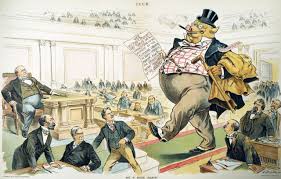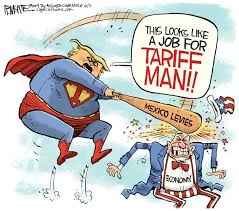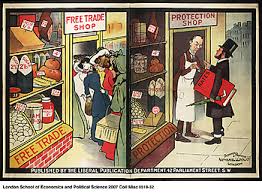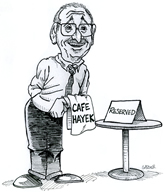George Will explains “how Trump dominates and corrupts the private sector.” Four slices:
After six months, with seven times that much time remaining, Trump 2.0 seems as transformative as the New Deal was, but different. Franklin D. Roosevelt’s legacy was the institutional architecture of the welfare and regulatory state. Donald Trump’s legacy will be a demonstration: How a purely transactional politician, untethered from any political philosophy and uninterested in norms of self-restraint (e.g., unforced respect for the separation of powers) can exploit this architecture for unconstrained executive power.
Trump’s ever-shifting and contradictory rationales for tariffs (curing trade deficits, strengthening national security, punishing ingratitude, etc.) reveal that protectionism is not an economic policy but a political strategy for aggrandizing personal power. His tornado of tariffs-by-whim produces an endless auction as businesses bid for beneficial whims: intensifications of, or exemptions from, tariffs.
As the American Enterprise Institute’s Dalibor Rohac says, when tariffs are multiple and malleable private rent-seeking (bending government for preferential treatment or for injurious treatment of competitors) displaces entrepreneurial talent and shrewd management as the path to economic success. Rent-seeking has always been with us, but not on today’s scale as innumerable factions become genuflecting supplicants, groveling for presidential favors.
The most statist administration in U.S. history has replaced capitalism with what economists call “economic repression”: government supplanting the market by restraining or compelling economic activities for political objectives.
…..
After a 18-month administrative-state farce involving faux “national security” worries, the government has allowed the sale of U.S. Steel to a private corporation headquartered in a close ally (Japan). Trump has, however, in effect nationalized U.S. Steel, which must give to presidents, in perpetuity, a “golden share” in the corporation. The New York Times explains: “U.S. Steel’s charter will list nearly a dozen activities the company cannot undertake without the approval of the American president or someone he designates.”
The ban on TikTok is a misguided law passed by large congressional majorities and unanimously affirmed by an excessively deferential Supreme Court, its intelligence perhaps bewitched by presidential solemnities about “national security.” The law, which went into effect Jan. 19, stipulates that to facilitate the sale of the app to a non-Chinese entity, the president can grant one extension, up to 90 days, of nonenforcement.
Trump has now ordered two more extensions, while disregarding the law’s stipulation that he justify an extension to Congress by certifying concrete progress toward TikTok’s divestiture. This is not enforcement discretion, it is nullification of a law — a veto without an opportunity for Congress to override it. In 1838, the Supreme Court termed “entirely inadmissible” the idea that the president has (as English kings once had) a “dispensing power” to “license illegal conduct” or the power “to forbid … execution” of laws. Never mind constitutional morality. Trump is not mistaken in regarding laws as mere whispered suggestions from Congress until it rediscovers its pride and grows a spine.
…..
Today’s administrative state, suffocating society with enveloping laws and regulations, can be wielded like a cudgel by a president enjoying seemingly limitless discretion as congressional majorities choose to be ciphers. A president without constitutional scruples is not limited by institutions that are theoretically, but not actually, rivalrous.
…..
Today’s shambolic civic life, with the public sector dominating and corrupting the private sector, reveals this: The Founders’ elegant architecture of institutions for liberty under limited government guarantees nothing when the institutions are inhabited by the unenlightened.
Ed Fuelner has died at the age of 83. This piece, written with Mike Pence, was published just a week or two ago; it warns of the dangers to populism. (HT Phil Magness) A slice:
Rather than advance the American-led internationalism of our country at the height of its powers, populism complains that our allies and trading partners have taken advantage of us, and that we need tariffs to settle the score, even at the expense of our own national security and economic growth. Rather than uphold the long memory of the British colonists, who were suspicious of monarchical government’s abuse of power, populism clamors for more centralization in Washington to work our will for the common good. Rather than Edmund Burke’s belief that men have “a right to the fruits of their industry and to the means of making their industry fruitful,” populists insist we weaponize the administrative state to compel businesses to act in our favor.
The Biden Administration stretched antitrust laws for political ends, and now the Trump crowd is doing the same. The latest exhibit is the Justice Department’s bizarre legal filing in a lawsuit (Children’s Health Defense v. WP Company) by anti-vaccine activists against media companies.
…..
Justice claims that antitrust laws bar even “tacit” collusive agreements, which can involve merely a “‘wink and a nod’ or an informal ‘gentleman’s agreement or understanding.’” Under this standard, the media coverup of Joe Biden’s decline could be an antitrust violation.
One irony is that Biden officials threatened big digital platforms with antitrust regulation if they didn’t censor alleged misinformation. The Trump DOJ is doing the reverse. Its legal filing threatens platforms with antitrust liability if they take down content for whatever reason because doing so would suppress viewpoint competition.
Peter Earle uses the changing chicken sandwich to celebrate capitalism. A slice:
A recent meme points to the ubiquity of chicken sandwiches across major fast food chains as supposed evidence of stagnation in capitalism. If twelve top firms offer a similar product, the argument goes, how innovative can an economic system truly be?
But that line of reasoning badly misrepresents both the nature of competition and the role of iterative improvement in markets. The explosion of chicken sandwich options is not a sign of creative bankruptcy — it’s a case study in product refinement, branding evolution, and consumer-focused differentiation. Far from signaling sameness, the chicken sandwich wars reveal how even within a narrow category, firms continuously jockey to win customer loyalty, and with it, market share.
Chicken dishes — especially fried chicken and chicken sandwiches — have become a cornerstone of American food culture, driven by its broad appeal, versatility, and relative affordability. In recent years, chicken sandwiches have surged in popularity, with the 2019 “chicken sandwich wars” showcasing consumer demand and brand competition. Today, nearly every major fast food chain (in industry parlance, a quick-service restaurant or QSR) offers at least one signature chicken sandwich, alongside consumer favorites like traditional beef burgers. Every firm named in this meme has innovated in some way or another — more frequently, in several.
But the academic environment nonetheless remains tilted toward left-leaning ideas, especially when it comes to economics. I asked Lawrence Reed, former president of FEE, why free-market ideas receive less attention than more interventionist ideas in today’s universities. He cited Thomas Sowell, who once wrote, “The most fundamental fact about the ideas of the political left is that they do not work. Therefore we should not be surprised to find the left concentrated in institutions where ideas do not have to work in order to survive.” Sowell discusses how academic Marxists are unaffected by the blatant failures of socialism in the real world, claiming that professors can produce whatever content they want as long as the topic is ideologically fashionable enough. He concludes that leftists concentrate in places where it doesn’t matter whether or not their ideas “stand the test of performance,” leading many of them to be drawn to academia.


 Concerns abound in their [“common-good conservatives'”] essays and tweets for the moral poverty that capitalism in particular is said to engender. Economic freedom, with its emphasis on choice, allegedly draws people away from their own best interests (as nebulously defined by the common-good conservatives). The policy program, if you can call it that, is short on specifics. The most you can say is that it revolves around state action to ensure the common good. On social policy they are traditionalist: pro-life, pro-family, anti-woke. On economics they are dirigiste – that is, they promote government intervention in the private market to support outcomes they call “worker friendly”: pro-planning, pro-redistribution, anti-business. They want an industrial policy, so they can pick winners and protect certain industries from competition. They want power.
Concerns abound in their [“common-good conservatives'”] essays and tweets for the moral poverty that capitalism in particular is said to engender. Economic freedom, with its emphasis on choice, allegedly draws people away from their own best interests (as nebulously defined by the common-good conservatives). The policy program, if you can call it that, is short on specifics. The most you can say is that it revolves around state action to ensure the common good. On social policy they are traditionalist: pro-life, pro-family, anti-woke. On economics they are dirigiste – that is, they promote government intervention in the private market to support outcomes they call “worker friendly”: pro-planning, pro-redistribution, anti-business. They want an industrial policy, so they can pick winners and protect certain industries from competition. They want power. In as far as inequality of human condition is the result of natural causes it affords no just topic of complaint; but in as far as it is brought about by the intermeddling of legislation, among a people who proclaim, as the foundation maxim of all their political institutions, the equality of the rights of man, it furnishes a merited reprehension.
In as far as inequality of human condition is the result of natural causes it affords no just topic of complaint; but in as far as it is brought about by the intermeddling of legislation, among a people who proclaim, as the foundation maxim of all their political institutions, the equality of the rights of man, it furnishes a merited reprehension. The stupidity of trade wars knows no limit.
The stupidity of trade wars knows no limit. I asked myself, what do industry and labor want from the regulators? They want protection from competition, from technological change, and from losses that threaten profits and jobs. A carefully constructed regulation can accomplished all kinds of anticompetitive goals of this sort, while giving the citizenry the impression that the only goal is to serve the public interest.
I asked myself, what do industry and labor want from the regulators? They want protection from competition, from technological change, and from losses that threaten profits and jobs. A carefully constructed regulation can accomplished all kinds of anticompetitive goals of this sort, while giving the citizenry the impression that the only goal is to serve the public interest. A nation that contains firms that are operating (as a whole or to some extent) only because they are protected by tariffs from competing foreign sellers is a nation that is misallocating its productive resources and impoverishing itself. This is not really a debatable proposition; it’s as basic as basic economics can get. Using resources to produce outputs that have a lesser free-market value than the outputs that could have been produced by those same resources in an alternative use sacrifices wealth; the opportunity cost is greater than the value created. That’s waste.
A nation that contains firms that are operating (as a whole or to some extent) only because they are protected by tariffs from competing foreign sellers is a nation that is misallocating its productive resources and impoverishing itself. This is not really a debatable proposition; it’s as basic as basic economics can get. Using resources to produce outputs that have a lesser free-market value than the outputs that could have been produced by those same resources in an alternative use sacrifices wealth; the opportunity cost is greater than the value created. That’s waste. In commercial societies governed by the rule of law, Smith holds, the rich may have a great deal of purchasing power, but their wealth does not lead to direct authority over others since everyone stands in a market relationship with everyone else and there are generally a multitude of potential buyers, sellers, and employers.
In commercial societies governed by the rule of law, Smith holds, the rich may have a great deal of purchasing power, but their wealth does not lead to direct authority over others since everyone stands in a market relationship with everyone else and there are generally a multitude of potential buyers, sellers, and employers.
